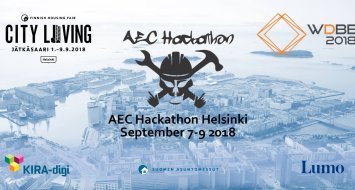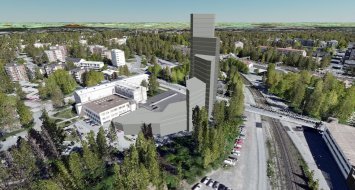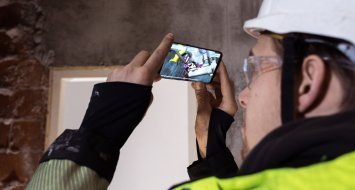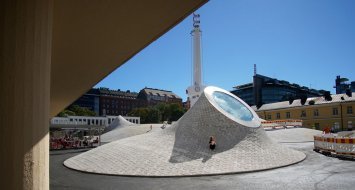The AEC Hackathon on September 7-9, 2018, was a part of Housing Fair Finland’s City Living event. The winning hack teams presented three quite different solutions to the hackathon challenges.
The hackathon took place in a school building constructed in 1878 that the current owner, Kojamo, is developing into a hotel. The three hackathon challenges were related to the themes of building and city living. The challenges and their sponsors were: 1) Living as a Service by Lumo/Kojamo, 2) City as a Service by Housing Fair Finland, and 3) an open challenge by KIRA-digi.
Here are summaries of the entries from the three winning teams and their respective prizes:
1st Place: Team Blurring Boundaries / EUR 2500 + Lumo Weekend Get-away
The team created a concept called Lumo Homel. It combines the familiarity of a home with the flexibility and convenience of a hotel. The concept is especially aimed at the under-30 generation who typically do not own homes and are open to alternative kinds of housing.
The basic services of Homel include a private room with utilities, access to common areas, and a WiFi connection. Premium services include apartment customization, room service with a changing daily menu, and experiences like tours and events.
There are four Lumo Homel subscriptions at reasonable prices: a day pass, a one-month package, a one- to three-month package, and “a home away from home” option for longer stays. This ensures that the hotel’s occupancy rate stays high at all times.
The team presented a customer journey map and a mobile app prototype for Lumo Homel. On the app, you can, for example, reserve a room, order food, and connect with other members of the Lumo community, the latter being an essential ingredient of the concept.
In addition to the mobile app, the team demonstrated a larger touch-screen app. It shows an exploded view of the building’s BIM model. With the app, you can locate vacant rooms, find your own room, find emergency services, and discover events taking place in the building. Owners and building operators can use the data from the building’s sensors and its customers’ actions using a backstage app.
The team suggested that the concept could be scaled up to neighborhood and city levels. The services and events in the area could be integrated into the same service and accessed via the app.
Contact Anna Boguslavsky for more information.
2nd Place: Team Huolto Tonttu / EUR 1500
Every building has more or less significant issues with lighting, ventilation, waste disposal, and so on. Each of these raises the potential health problems within the building, which is why it’s important to understand their causes.
Every day, building owners and facility managers receive a number of service requests from building users. A large property owner’s FM system can store millions of free text logs annually. The team wanted to find out which issues take the most time to address, which are most common, and information about the trend lines of the issues. The answers to these questions help a building owner accurately plan and budget for operations, estimate and anticipate issues, and target critical issues globally. Predictive, rather than reactive, maintenance helps keep users happy.
Service requests reveal that people use several alternative phrases to describe the same issue. For example, they may write: “A lamp is burned out,” “a lamp is broken,” or “a fluorescent light is blinking.” As these all mean the same thing, a predictive analysis should treat them as the same input.
Humans have trouble gaining insights from large natural language data sets. That’s why they use data models to force users to describe issues in a standardized way. The team is opposed to data models because they believe they create data silos that hamper interoperability.
The team’s solution is Huolto Tonttu (a Finnish name meaning “maintenance goblin”). It is an AI system that inputs natural language service requests and processes a semantic summary of them.
The team demonstrated a user interface they created over the weekend using data from Granlund Manager, a piece of facilities management software. The UI shows as graphs summarizing answers to the questions essential to the building owner. It also displays a detailed breakdown of the set of topics contained in each term.
The analysis highlights where the issues are located in the building, e.g., by floor or section, and the average duration and duration variance to solve each type of issue. A search function allows further analysis of the data. A seasonal view reveals any trending topics over several years.
The team emphasized that their solution is independent of data standards, that it uses open source algorithms, and that the data is secure and owned by the clients.
Contact Vincent Kuo for more information.
3rd Place: Team MoldZilla / EUR 1000
The team members described themselves as engineers having superpowers so that they can defeat MoldZilla, a mold monster that pesters building users.
Mold in buildings is a big issue because it is a potential health hazard. The problem starts at the design phase. Even with advanced FEM software, it takes a lot of time to calculate the mold-vulnerability of each structure.
The team wanted to find a way to do quick check-ups on structures, and their solution is data mining and artificial intelligence (AI). The AI app can predict with fair confidence whether a building is potentially vulnerable to mold or not.
The team devised a user interface for the app using an open source framework. The app connects to backend data sources and shows with color codes how safe a certain structure is.
Realtors and home buyers are able to use the app to check if an existing structure is safe from developing mold. Engineers can augment the existing FEM software analyses with the app’s predictions. Companies and building inspectors are able to use a “BIM scanner” to evaluate design solutions.
Contact Katja Rodionova for more information.
Other news

The Winning Teams at the AEC Hackathon Helsinki
The AEC Hackathon on September 7-9, 2018, was a part of Housing Fair Finland’s City Living...

City Development with Interactive 3D Models
The Finnish city of Hyvinkää has developed a unique internet service for collaborative 3D ...

BIM Meets Reality on the Construction Site
BIM models are mostly used by foremen on construction sites. But what if they could be mad...

How BIM Can Serve Building Owners
Building Information Models typically end their active life after the construction phase. ...

